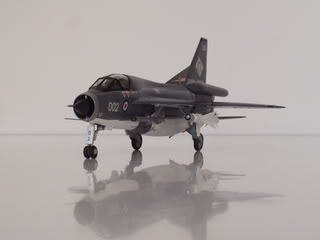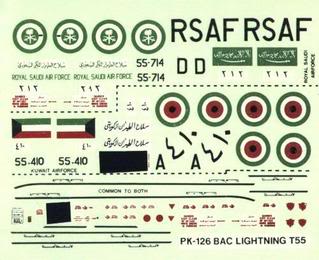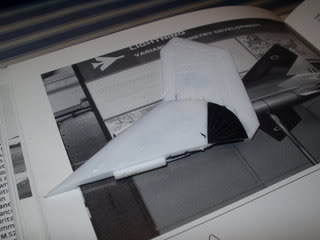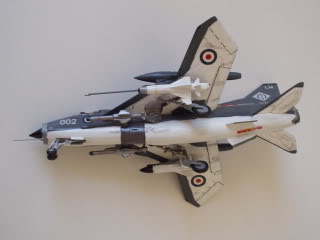BAC FAW 1 Sea Lightning
Variable Geometry BAC / English Electric Lightning in Naval Service
![]()
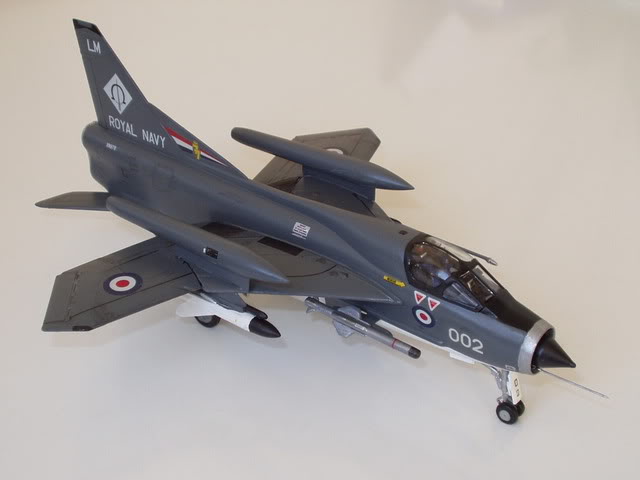
Converting the Matchbox T55 Lightning
This particular "what if?" project was inspired by a series of photographs in 2 excellent books; Tony Buttler’s “British Secret Projects, Jet Fighters Since 1950, and Derek Wood’s well known “Project Cancelled”, which both give details of a secret BAC mock up from the 1960s, of a proposed Variable Geometry (VG) Lightning.
I have always been a Lightning enthusiast; as a youth I remember watching RAF Leuchars based aircraft flying out over the North Sea, then later, during my Naval Service, watching astonishing displays by our affiliated RAF squadron (slow pass at bridge height, waving as they drew alongside, then standing on their tail and disappearing vertically into the sky).
However, as Naval Aviation is “my thing”, my modelling projects have generally ignored the Lightning, so I was surprised to discover that the photographs in question were actually for a Naval multi-role aircraft (fighter & attack) to replace the Sea Vixen in the mid-1970s. In the event, the design came to nothing; after the preferred P1154 project dissolved into shambles, the ubiquitous Phantom was selected instead. Nevertheless, as a “what if” project, the Sea Lightning clearly had potential.
Apart from the 2 books mentioned, which include plans for a further developed (and very ugly) solid nosed Sea-Lightning, details are hard to come by; what is clear is that the Sea Lightning proposal was based on the 2 seat trainer, with outer wing panels replaced by variable sweep sections (to reduce landing speed for the RN’s small contemporary carriers), a fin extension for longitudinal stability, a folding fin top section to meet below decks height clearances and new underwing weapon pylons.
|
|
In the fighter role, the Red Top missile (already in RN service with the Vixens) would be the main Air-to-Air weapon, with 2 carried on the standard fuselage pylons, whilst the additional wing pylons would be capable of carrying more Red Tops, or a variety of contemporary Air-to-Surface weapons. The proposal was promoted as low risk, using proven in-service fighter airframe, systems and engines, with comparatively minor modifications to meet the naval attack role.
|
The Matchbox Kit
In 1/72 scale, the only realistic option as a base kit is the venerable Matchbox T55 Lightning, which is currently out of production. This kit represents the late export variant based on the Lightning F6, with large belly fuel tank and cranked/cambered wing, as used by Saudi Arabia and Kuwait; this strange choice of mark, rather than the more common RAF Trainers (based on F1 and F3 versions), must have seriously limited the market appeal of the kit (converting it to an RAF trainer is a significant task), but means that unwanted kits can now be obtained reasonably easily on e-bay (I paid about 4 UK Pounds for mine). Dated 1982, it looks to be one of Matchbox’s better offerings, with three sprues in the trademark Matchbox 3 colours (1 white and 2 different greys) and one clear (but thick) transparent sprue for the canopy.

The infamous Matchbox “trencher” must have been on holiday when the kit was moulded, because detail is mainly raised, although rather heavy in places (his mate the bricklayer did them instead). However, moulding is crisp and the fit of parts workmanlike and precise (as with most Matchbox kits, it needed to be buildable by those with very basic skills!). I didn’t need filler on any parts of the kit that had not been modified by me, although the long wing roots might have needed a brief smear. Although this is definitely a basic kit, it certainly looks the part, capturing the complex shape of the side by side 2-seater fuselage well.
The cockpit is very basic; rear bulkhead, floor, 2 non-descript seats, 2 sticks, a flat instrument panel, 2 (identical) and demure looking pilots, plus a rather uninspiring decal of dials and gauges. The kit has one obvious shortfall that played in my favour; the inner wing section appears to be very thick, coincidentally making it ideal for a VG conversion! A less obvious shortfall is the presence of gun ports at the front of the underbelly fuel tank; as I understand it these were not fitted to the 2 seat variants, but for my purposes, seemed entirely appropriate for an attack variant. Wheel wells, as you would expect from Matchbox and the 1980s, are bare and unfilled.
Interestingly, the kit’s tailpipe is constructed from 4 separate parts, unlike the other Lightning kits I have built (Frog/Airfix/Hasegawa) who provide uninspiring single part shallow tailpipes. This would be a plus point for the kit, were it not for the fact that they are very plain looking and thick, however this is something that can be easily fixed with a bit of sharp scalpel sculpting (try saying that without your false teeth!). The nose cone is also provided in several parts; it has no intake trunking, but this is not readily apparent when the kit is completed. Mine was slightly deformed (with a witch-like hooked nose bit on the end!), but not a significant problem to fix.
Decals
|
As supplied, the kit can be made into 2 versions, both natural metal and covering both operational users, the Royal Saudi Air Force and the Kuwait Air Force. I have only seen one further colour scheme for the T55 and this is the temporary UK markings worn by the aircraft when they and their single seat companions were repurchased by British Aerospace and flown back to the UK for a possible sale to a European customer (Austria, I believe) which fell through. The supplied markings include comprehensive stencilling and warnings, as well as national markings and the many black panel lines seen on the real aircraft. Colour drawings are provided on the box back.
|
|
Bashing the Kit (Marinisation)
With very limited reference information, it was clear that building a Sea Lightning would require informed guesswork and logic to fill out the missing detail and development that real life rejected. I was happy to go with the T55 version as a baseline, since it represents the most advanced Lightning variant; the plans actually show an even bigger belly tank fitted, but I wanted to stick to the (more realistic) minimal necessary development route, plus I wanted to keep it recognisable as a Lightning. To give me some scope for imagination, I decided to build a speculative Lossiemouth based in-service aircraft, with ASuW mission outload, depicting what might have been, had the RN Phantom deal fallen through.
|
First area to receive attention was the VG wings; studying the photos and plans immediately identified some issues, with the wing pivot geometry and trailing edge profile on the BAC mock up looking decidedly improbable and no indication whatsoever as to how the standard outward folding undercarriage could be re-engineered away from the moving wing section (except for a vague statement in the references that it would be inward folding). After an entire evening making, cutting up and sticking together different cardboard wing profiles, I finally decided on a plan (and a new pivoting point) that seemed (at least to me) to be more credible than the mock up.
|
|
The lower wing moulding was carefully dissected into sections and the wheel bays attached to the upper section in reverse. This new wheelbay position dictated where the wing could feasibly pivot; the upper wing section was then cut in two, borrowing a feature from the Tornado (which, along with the F111, drew on the same line of NATO VG research as the VG Lightning study) by using a flexible wing glove to cover the resulting gap (modellers fudge or realistic proposition?). Given the importance of large flaps for a Naval Aircraft (can you “blow” a VG Flap?), I decided to kept the whole length of the trailing edge intact as part of the moving outer section (the plans show it splitting mid span), which again helped to make it look an altogether more probable arrangement. At this point, after a quick coat of Humbrol Extra Dark Sea Grey, I began to panic over the raised detail on the wings; with paint applied, the size of the raised lines became obvious; they looked more like spoilers and wing fences than detail, so they were all sanded down to more reasonable proportions.
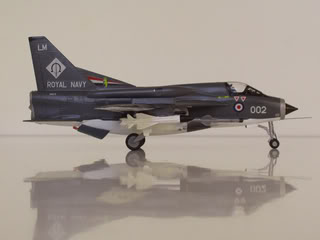
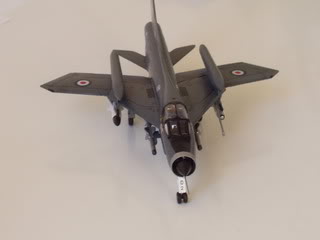
Apparently BAC’s study suggested that the VG wing would have been able to carry more fuel (always the Lightning’s weak point), but to be honest, after all the pivoting gubbins had been added, I doubt that there would have been any space for fuel at all ! With this in mind, I was determined to keep the Lightning’s (unique ?) overwing fuel tanks and pylons (narrowly resisting the urge to fit Saudi style Matra rocket pods to the front of the overwing tanks) and added an additional set of weapons pylons (ex-Airfix Buccaneer) in the same position underneath the wings. A thick plastic card fillet provided the fin extension, followed by a quick beefing up of the airfield arrestor hook for carrier landings and the main airframe changes were complete.
|
Next issue was the undercarriage; the Lightning has extremely narrow main wheels to fit into its thin wing; these looked far too flimsy for carrier operations and the high tyre pressures required would almost certainly have led to frequent bounces over the wires. As already mentioned, the Matchbox inner wing is very thick, and my wheels now folded inwards, so I substituted a set of large and solid Buccaneer wheels and legs, extending them by about 5mm to match the original Lightning set and adding suitable retraction jacks (actually the original Lightning legs) to hold them in place. |
|
With these hulking great tractor wheels fitted, the single Lightning nose wheel began to look flimsy too, so a set of redundant Tornado twin wheel nose gear was added, again extended in length, this time to give the aircraft a slight nose up attitude for carrier ops. To reflect their larger width and the lack of space in the aircraft nose, I reversed the forward gear pivot to retract backwards into the fuselage instead of forward. Undercarriage doors were fabricated from a mixture of plastic card and the Matchbox originals, suitable repositioned to match the new structure.
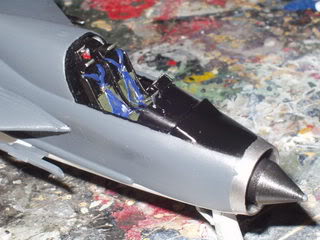
The supplied cockpit was decidedly minimalist, so to emphasise the Observer’s weapon control role, I added a couple of chunky black boxes to his position, using instrument decals from the spares box to simulate a weapons control and radar panel and placed an acetate HUD in the right hand pilots position. My initial (lazy) plan was to use the Matchbox pilot figures to fill the remaining empty space, but their “identicalness” looked wrong; a subsequent attempt to replace one of them with a differently posed Airfix figure simply highlighted the narrowness of the cockpit (ie, the 2 figures wouldn’t both fit !) so instead I spruced up the seats with some simple masking tape belts and added a few small boxes and a canopy lifting arm to the rear bulkhead. With the canopy added and painted, the effect was very pleasing; not superdetailing by any means, but it made the desired point.
Marking, Arming and Details
After an second coat of Humbrol Extra Dark Sea Grey, it was time to add the armament; 2 Red Tops from the kit, plus 2 Martel ASMs (1x Anti-Radar, 1xTV) taken from the Airfix Buccaneer. The characteristically long Lightning pitot tube looked as though it would be a real nuisance above and below deck, so was replaced with a smaller (Sea Harrier sized) version using a suitable steel pin.
As I intended the aircraft to be a Phantom alternative, a suitable colour scheme and markings were selected. After much consideration I painted the undersides white with a low demarcation line (as per the Phantoms). Even though the contemporary Buccaneer squadrons found this scheme unsuitable for low level attack and adopted wraparound EDSG instead, it does add some interest to what would otherwise be another boring overall grey aircraft! A quick coat of Future provided a base for the decals, which were a mix from the kit and parts box (mainly ex Frog Sea Vixen, Fujimi F4K and Modeldecal), again concentrating on the Phantom/Buccaneer period for inspiration. Those kit decals that I used gave me no real problems, except for exuding a white slimy substance, that I assume is some form of adhesive (possibly degraded with age). I have seen this on several Matchbox decals; it comes off easily if you wish, but in fact it seems to dry clear in any event; liberal application of Humbrol Decalfix allowed all of the decals to settle down well onto the surface.
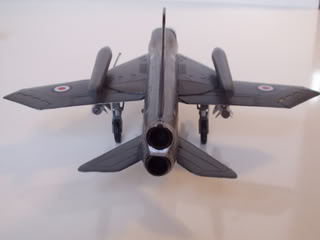
Could It Really Have Flown ?
OK; so a lot of what I have done here is pure speculation. Nevertheless, this was a real proposal by BAC to take an existing, proven and capable aircraft, with development potential and apply NATO funded VG research to provide a realistic contender for the Sea Vixen replacement. The fact that it made it as far as an official model demonstrates that this was not simply a routine drawing office design exercise.
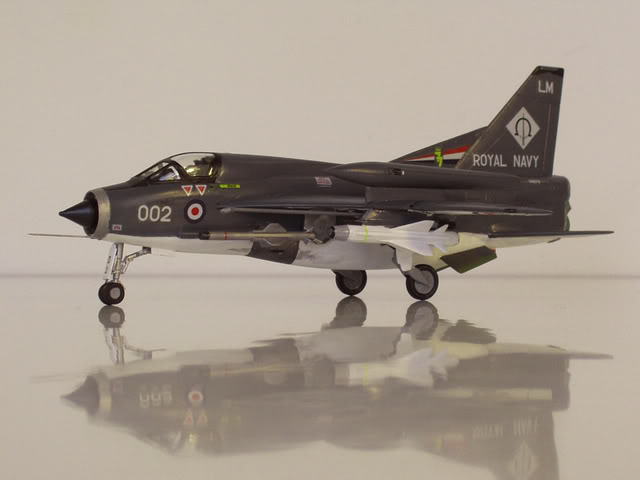
But whether or not a VG Sea Lightning would really have been a “low risk” minimal enhancement is a matter of debate. Personally, and with a cynicism born of real procurement experience, I suspect that the problems I found in changing the kit would have had their real life equivalents; issues such as wing pivoting geometry (and hence CofG), limited wing fuel capacity, flap size and position, undercarriage position and strength, not to mention integration of the new attack weapons into the Lightning’s interceptor systems, fitting additional naval navigation equipment/radios etc and marinisation of components vulnerable to salt water, would all have conspired to raise costs and delay entry into service.
Furthermore, the Lightning was famously difficult to maintain ashore in heated, well equipped and spacious hangars; so imagine doing an engine change on a heaving deck, inside a crowded ship’s hangar. I think not. But it does look good . . . . . .and I certainly had a lot of fun building it!
References:
1. Wood D. Project Cancelled – The disaster of Britain’s Abandoned Aircraft Projects. 2nd ed. London, JANES, 1986. Pages 181-183.
2. Buttler T. British Secret Projects - Jet Fighters Since 1950. London, Midland Publishing, 2005. Pages 114-116.
3. Thunder & Lightnings [online]. 2005. Available at: http://www.thunder-and-lightnings.co.uk/contents.html [Accessed 6 Jan 06].
4. http://www.lightning.org.uk/home.html
5. Beedal C. Navy Matters - CVA01 [online]. 2005. Available at http://navy-matters.beedall.com/cva01.htm [Accessed 6 Jan 06].
6. Great Britain. Ministry Of Defence. Royal Navy Website [online]. 2006. Available at: http://www.royal-navy.mod.uk [Accessed 6 Jan 06].
Copyright 2007 Fred Tulloch
(if you can't see the Website Navigation Bar try this link to restore it)
